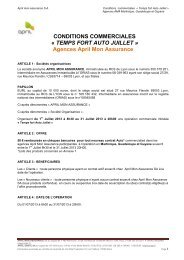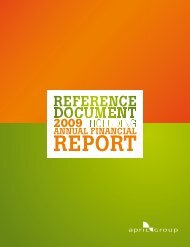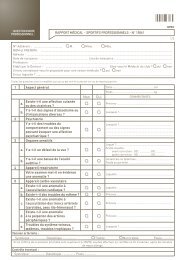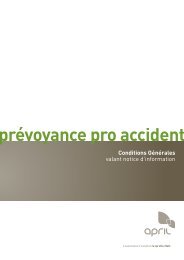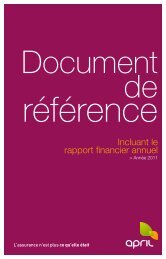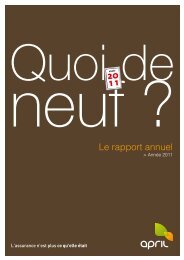2007 - April
2007 - April
2007 - April
You also want an ePaper? Increase the reach of your titles
YUMPU automatically turns print PDFs into web optimized ePapers that Google loves.
2.0<br />
Notes to the consolidated financial statements at December 31 st <strong>2007</strong><br />
Financial investments for insurance activities, which are<br />
valued in accordance with IAS 32 and 39,<br />
Trade receivables, which are broken down into receivables<br />
from insurance operations and reinsurance accepted and<br />
receivables from cession operations on reinsurance,<br />
Operating liabilities, which are also broken down, with<br />
liabilities from insurance operations and reinsurance<br />
accepted and liabilities from cession operations on<br />
reinsurance,<br />
Underwriting provisions, which are booked gross under<br />
liabilities, with the reinsured portion under assets: transferee<br />
and retrocession share in underwriting provisions<br />
and financial liabilities.<br />
Financial liabilities are broken down in order to differentiate<br />
between technical liabilities on investment policies and<br />
financial debt.<br />
1.5.2. Presentation of the income statement<br />
The income statement is presented with a breakdown<br />
for each type of entry, in line with CNC recommendation<br />
2004-R.02 dated October 27 th , 2004 and factoring in the<br />
specific aggregates for insurance companies:<br />
Inderwriting expenses for insurance policies (cf. note 1.8);<br />
The result for reinsurance “net income or expenses for<br />
reinsurance cessions” (cf. note 1.9).<br />
The figure for financial income net of charges and excluding<br />
cost of debt corresponds to revenues and earnings from the<br />
disposal of insurance company investments and operating<br />
cash-flow from the brokerage activities.<br />
It also includes the change in the fair value of financial<br />
instruments recorded at their fair value and earnings. Since<br />
it is directly linked to the APRIL GROUP’s financial model<br />
and activities, both for the insurance business and for<br />
brokerage activities, which generate a cash surplus, they are<br />
incorporated into «income from ordinary activities”.<br />
1.6. Revenues<br />
Revenues comprise:<br />
Acquisition commissions in payment of business<br />
contributions,<br />
Management commissions in payment of administrative<br />
functions,<br />
Development commissions based on underwriting portfolio<br />
results,<br />
Insurance premiums gross of reinsurance,<br />
Acceptance premiums,<br />
Services provided.<br />
The principles for recording and recognizing revenues<br />
are as follows:<br />
For acquisition and management commissions: revenues<br />
comprise the share in commissions relating to premiums<br />
acquired over the period.<br />
For development commissions: they are recorded in the<br />
year of acquisition insofar as they can be reliably valued.<br />
Otherwise, they are recorded upon collection.<br />
For insurance premiums: revenues comprise premiums issued<br />
and to be issued, acquired as on the date for the close of<br />
accounts, net of cancellations and gross of reinsurance.<br />
Premiums linked to investment policies without any<br />
discretionary profit-sharing are not recognized under<br />
revenues.<br />
For services provided: revenues are taken into account as<br />
of the service performance start date. Income is taken into<br />
account as and when services are delivered.<br />
At year-end, the commissions corresponding to the nonexecuted<br />
fraction of policies represent pre-booked income..<br />
1.7. Financial income net of charges and excluding cost<br />
of debt<br />
Financial income net of charges groups together all financial<br />
income and expenses excluding the cost of debt:<br />
Financial income from insurance company investments,<br />
Revenues from cash and cash equivalent investments,<br />
Financial expenses linked to such investments (including<br />
external management costs),<br />
Changes in the fair value of investments against earnings,<br />
Capital gains and losses on disposals net of provisions and<br />
write-backs for depreciation.<br />
The cost of debt primarily corresponds to financial expenses<br />
incurred on funds borrowed.<br />
100<br />
Return to the contents section




